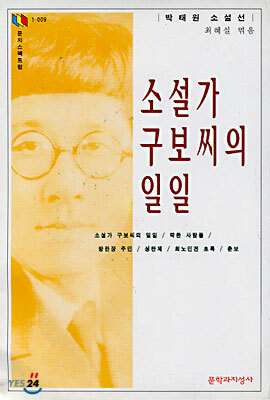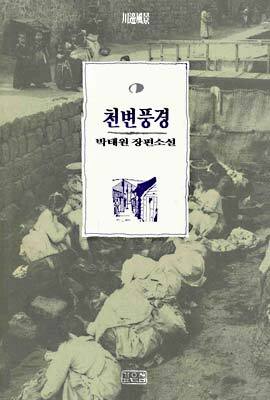Pak Taewon (1909 – 1986) was a modern South Korean writer who moved to North Korea.
Life
Pak Taewon was born in Seoul, Korea on December 7, 1909. He wrote under the pen names Mongbo and Gubo. Pak attended Hosei University, Japan, but did not graduate.
Pak debuted as a poet while still a high school student, when his poem "Nunim" (누님 Elder Sister) won honorable mention in a contest sponsored by the journal Joseon Mundan; and as a fiction writer in 1929 with the publication of his short story, "Suyeom" (수염 Beard) in Sinsaeng magazine. Pak joined the Group of Nine (Guinhoe, a group that also included Yi Sang) in 1930 and devoted himself to fiction thereafter. Upon the liberation of Korea in 1945, he became a member of the Central Executive Committee of the Korean Writers’ Alliance.
In 1950, Pak crossed the 38th Parallel into North Korea where he wrote and worked as a professor at Pyeongyang Literature University. He was purged and prohibited from writing in 1956, but his writing privileges were reinstated in 1960.
Pak died on July 10, 1986 in North Korea. His grandson, through a daughter he left in South Korea, is the film director Bong Joon-ho.
Writing
A modernist writer who boldly embraced experimental techniques and meticulous craftsmanship, Pak Taewon was primarily concerned with the aestheticism and the mode of expression itself rather than the ideas expressed. His early fictional works, in particular, were a product of his attempt to engineer a new writing style: "Piro" (피로 Exhaustion) and "Ttakhan saramdeul" (딱한 사람들Forlorn People) contain symbols and diagrams from newspaper advertisements; "Jeonmal" (전말 Circumstances) and "Biryang" (비량 Sorrow), contain long phrases composed of over five sentences strung together with commas.
Pak, along with Yi Sang, rejected didactic literature, and stressed the importance of appreciating literature as a linguistic art, not as a medium for conveying ideologies. In the latter half of the 1930s, however, he came to focus increasingly on the customs and mannerisms of the time, and eventually abandoned his interest in stylistic invention. Soseolga gubossiui iril (소설가 구보씨의 일일 A Day in the Life of Mr. Gubo, Novelist), serialized in the Chosun Joongang Ilbo from August 1 to September 19, 1934, is a semi-autobiographical novella depicting a series of observations made by a writer taking a walk around the city. Pak's Cheonbyeon punggyeong (천변풍경 Scenes by a Stream), an elaborate portrait of urban manners and working class life presented episodically, is often regarded as the representative modernist novel of the 1930s. After Korea regained independence, Pak turned to historical issues and problems of national identity, and began to write historical novels almost exclusively.
Pak T’aewǒn - pseudonim Kubo - urodził się 7 grudnia 1909 roku w Seulu. Po ukończeniu szkoły powszechnej, wstąpił do Liceum Ogólnokształcącego Kyǒngsǒng Cheil. Jeszcze w trakcie nauki w liceum rozpoczął karierę literacką, publikując wiersze i opowiadania w różnych magazynach literackich. Zadebiutował wierszem Starsza Siostra, za który dostał w 1926 roku wyróżnienie w konkursie zorganizowanym przez czasopismo Świat Literatury Chosǒn. W 1929 roku rozpoczął studia na uniwersytecie Hosei w Japonii, ale ich nie ukończył. Po powrocie do kraju w 1930 roku zdobył sobie uznanie jako pisarz po opublikowaniu w Nowym Życiu noweli pt. Broda. Jego mentorem był Yi Kwangsu, ale Pak T’aewǒn przeciwstawił się później poglądom swego mistrza, który uważał, że literatura powinna nieść oświecenie. W 1933 roku przyłączył się do grupy artystycznej Stowarzyszenie Dziewięciu (Ku-in-hoe), do którego należeli również inni słynni pisarze koreańscy tacy jak: Yi T’aejun, Chǒng Chiyong, Kim Kirim czy Isang. Od drugiej połowy lat trzydziestych wykazywał jednak zwiększone zainteresowanie obyczajami tamtych czasów. Dzień z życia pisarza Kubo, który był publikowany w odcinkach w gazecie Chosǒn Chunggang Ilbo późnym latem 1934 roku, to częściowo autobiograficzna powieść przedstawiająca refleksje pisarza spacerującego ulicami Seulu. Pak T’aewǒn zmarł 10 lipca 1986 roku
Este escritor modernista, que adoptó técnicas experimentales y un meticuloso método de trabajo, estaba comprometido principalmente con la estética y el modo de expresión en sí mismo más que en las ideas expresadas. Sus primeras obras de ficción, en particular, fueron producto de sus intentos de crear un nuevo estilo de escritura. Por ejemplo, "Agotamiento" (Piro, 1933) y "Gente desgraciada" (Ttakhan saramdeul, 1934) contienen símbolos y diagramas de anuncios de periódicos; "Las circunstancias" (Jeonmal, 1935) y "Biryang" (Biryang, 1936) contienen largas frases compuestas de más de cinco oraciones conectadas con comas.6
Park Taewon, junto con Yi Sang, rechazaron la literatura tendenciosa e insistieron en la importancia de apreciar la literatura como un arte lingüístico, no como un medio para trasmitir ideologías. En la segunda mitad de los años treinta se empezó a interesar por las costumbres y los manierismos de la época, y finalmente abandonó el interés por la invención estilística. Un día en la vida del novelista Gubo (Soseolga Gubossiui 1 il), una novela corta publicada de forma serial en el periódico Chosun Joongang Ilbo del 1 de agosto al 19 de septiembre de 1934, es una obra semi-autobiográfica que describe una serie de observaciones hechas por un escritor que da un paseo por la ciudad. Escenas junto al riachuelo (Cheonbyeon punggyeong, 1936-1937), es un elaborado retrato del modo de vida en la ciudad y de la clase obrera presentado por episodios, y se la considera una novela modernista representativa de los años treinta. Después de que Corea consiguiera la independencia, empezó a escribir sobre temas históricos y problemas de identidad nacional, dedicándose casi exclusivamente a la novela histórica.7
L'Institut coréen de la traduction littéraire (LTI of Korea) décrit son œuvre de cette manière :
Bak Tae-weon est un écrivain dit "moderniste" qui n'a eu de cesse d'expérimenter de nouvelles techniques d'écriture tel un artisan.Il a porté principalement son attention sur l'esthétisme des phrases et sur les façons de s'exprimer plutôt que sur les idées exprimées. Ses premières œuvres de fiction reflètent ses tentatives pour développer un nouveau style d'écriture : La fatigue (Piro, 1933) et Les gens malheureux (Ttakhan saramdeul, 1934) contiennent par exemple des symboles et des diagrammes extraits de publicités dans les journaux ; ses nouvelles Circonstances (Jeonmal, 1935) et Triste et froid (Biryang, 1936) contiennent de longues phrases composées d'au moins cinq lignes reliées simplement avec des virgules5 .
Tout comme le poète Yi Sang, il a rejeté la littérature traditionnelle, et a souligné l'importance d'apprécier la littérature comme un art du langage et non pas comme un moyen de véhiculer des idéologies. Pourtant, durant la seconde moitié des années 1930, il a commencé à concentrer son écriture de plus en plus sur les coutumes et les usages de son époque, et a finalement abandonné son intérêt pour le développement de nouveaux styles d'écriture. Une journée dans la vie du romancier Gu-bo (Soseolga Gubossi-ui 1 il), publié en feuilleton dans le journal Chosun Ilbo du 1er Août au 19 Septembre 1934, est un roman semi-autobiographique décrivant les observations d'un écrivain se promenant au hasard des rues. Le paysage au bord de la rivière (Cheonbyeon punggyeong, 1936-1937) est un portrait complexe des mœurs urbaines et de la vie ouvrière durant son époque, Ce dernier roman est souvent considéré comme le roman moderniste représentatif des années 1930. Après l'indépendance de la Corée, Bak s'est davantage tourné vers les questions et les problèmes liés à l'identité nationale, notamment à travers l'histoire. Il n'a dès lors écrit quasiment que des romans historiques5.
Pak Taewon wurde am 7. Dezember 1909 in Seoul, Korea geboren. Sein Künstlername ist Kubo (구보丘甫). Er besuchte die 1. Oberschule Kyŏngsŏng und fing 1930 sein Studium an der Hosei University in Japan an, brach dieses jedoch ohne einen Abschluss wieder ab. Als Dichter debütierte er bereits während seiner Zeit in der Oberstufe, als sein Werk Große Schwester (누님) in einem Wettbewerb ausgezeichnet wurde. Sein Debüt als Schriftsteller hatte er 1929 mit der Kurzgeschichte Der Bart (수염), die in der Zeitschrift "Neues Leben" (신생) veröffentlicht wurde. 1930 trat er dem "Zirkel der Neun" (구인회九人會) bei und widmete sich von da an eher dem Schreiben von Romanen. Nach der Befreiung 1945 wurde er Mitglied des Zentralkomitees der Vereinigung der Schriftsteller Koreas (조선문학가동맹의 중앙집행위원). Während des Koreakriegs zog er in den Norden Koreas und verstarb dort am 10. Juli 1986.
Als Modernist, der gewagt experimentelle Techniken mit akkurater Handwerkskunst verband, beschäftigte er sich mehr mit Ästhetizismus und Ausdruck selbst als mit den Ideen, die ausgedrückt werden sollten. In seinen frühen Werke versuchte er, einen neuen Schreibstil zu konstruieren, z. B. durch die Verwendung von Symbolen und Grafiken aus Zeitungsannoncen oder Kommas. Als Mitglied des "Zirkels der Neun" lehnte er wie auch Yi Sang die Tendenzliteratur ab und betonte, wie wichtig es sei, Literatur als sprachliche Kunst zu betrachten und nicht als Medium, um Ideologien zu übermitteln. In den späten 1930er Jahren konzentrierte er sich verstärkt auf die Gewohnheiten und Eigenheiten der Zeit und letztlich verlor er das Interesse daran, neue Stilmittel auszuprobieren. Nach der Befreiung beschäftigte er sich mit historischen Themen und Problemen der nationalen Identität und verfasste beinahe ausschließlich historische Romane.[3]
박태원(1910~1986)은 대한민국의 소설가다.
생애
박태원은 1910년 서울 종로에서 태어났다. 경성사범부속보통학교, 경성제일고등보통학교를 나왔으며, 학창 시절 외국 문학을 탐독했다. 이 시기에 춘원 이광수와 백화 양건식을 스승으로 모셨으며, 1926년 《조선문단》에 시 〈누님〉을 발표하기도 했다. 1929년 일본으로 유학을 떠나 도쿄 호세이 대학 예과에 입학했으나 중퇴했다. 귀국한 이후 단편소설 〈적멸〉(1930), 〈수염〉(1930) 등을 발표하며 본격적으로 작품 활동을 시작하였다. 1933년 문학단체인 ‘구인회’에 가입하여 예술파 작가로서 지위를 확고히 하였다.
이후 단편소설 〈소설가 구보 씨의 일일〉(1934), 장편소설 《천변풍경》(1937) 등을 발표하며 실험적이고 기교적인 작가, 모더니즘 소설가로서 명성을 쌓았다. 1940년 돈암동으로 이사한 후, 일제 말기 작가의 내면을 고백하는 작품들을 쓰는 한편, 중국 문학과 역사물의 번역을 활발하게 했다.
해방 이후에는 조선문학가동맹 집행위원, 조선문학건설본부 소설부 중앙위원회 조직 임원으로 선정되었으나 적극적으로 활동하지는 않았다. 1950년 한국전쟁 시기에 월북하여 역사소설들을 발표하였다. 그 중 장편역사소설 《갑오농민전쟁》(1984)은 북한 최고의 역사소설로 평가받았다. 1986년 세상을 떠났다.
작품세계
박태원의 문학적 활동은 1933년 ‘구인회’에 가입하면서 본격화되었다. 작가의 대표작인 단편소설 〈소설가 구보 씨의 일일〉(1934)과 장편소설 《천변풍경》(1936)은 작가의 문학적 기법과 성과를 동시에 보여주는 작품으로 평가된다.
〈소설가 구보 씨의 일일〉은 고도의 소설적 기교를 사용하여 모더니스트로서의 작가적 특성을 잘 드러내고 있는 작품이다. 작가는 주인공인 소설가인 구보가 집을 나서서 서울 거리를 배회하고 다시 돌아오는 과정으로 이야기를 전개한다. 작품은 소설의 서사성은 약하지만 주인공의 내면세계가 부각되며, 의식의 흐름이나 몽타주 기법이 사용된 실험적인 작품이다. 또한 소설가 주인공을 통해서 소설 쓰기의 과정 그 자체가 작품의 주제가 됨으로써 문학에 대한 인식의 전환을 드러내고 있다.
장편소설 《천변풍경》은 연재 당시부터 평단의 관심을 끌었다. 카프 계열의 문학가인 임화는 이 작품을 두고 ‘세태 소설’이라 규정했으나 최재서와 같은 문학가들은 묘사의 객관성을 들어 ‘리얼리즘의 확대’라 높이 평가하기도 했다. 이 작품은 서울의 청계천을 중심으로 주변 사람들의 이야기가 옴니버스식으로 전개되어 있다. ‘천변(川邊)’이라는 공간을 중심으로 살아가는 사람들의 다양한 삶의 삽화들 그리고 인물이나 사건의 총체성보다는 공간의 총체성을 확보하고 있다.
주요 작품
1) 소설집
《소설가 구보씨의 일일》, 문장사, 1938.
《박태원 단편집》, 학예사, 1939.
《군국의 어머니》, 조광사, 1942.
《조선독립순국열사전》, 유문각, 1946.
《성탄제》, 을유문화사, 1948.
《중국소설선》, 정음사, 1948.
《조선창극집》, 국립출판사, 1955.
《정수동 일화집》, 국립출판사, 1955.
《야담집》, 국립출판사, 1955.
《심청전》, 문학예술서적출판, 1958.
2) 장편소설
《천변풍경》, 박문서관, 1938.
《금은탑》, 한성도서, 1948.
《홍길동전》, 조선금융조합연합, 1949.
《리순신 장군 이야기》, 국립출판사, 1955.
《이순신장군전》, 국립출판사, 1959.
《삼국연의》, 국립출판사, 1964.
《계명산천은 밝아오느냐》, 문예출판사, 1966.
《갑오농민전쟁》, 문예출판사, 1986.





